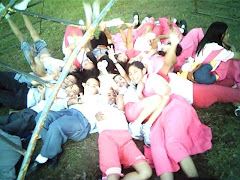ALOHA!
HCEC-BUHI 6th Foundation Day Special
Mountains rising to more than 4,000 meters (13,000 feet) above sea level; great stretches of barren lava beds; golden beaches rimmed by palm trees; magnificent cliffs and brightly colored canyons; dense rain forests and arid thorny scrublands; and a multi-hued patchwork of field and forest….. IN SHORT, A TASTE OF HEAVEN ON EARTH
That’s the volcanic
Hawaiian ladies are notoriously famous for their beguiling charm and engaging smile. Now, here’s a lady we know who possesses the same … to render us a warm welcome, ladies and gentlemen, The President of PTA Executive Board, MRS DALISAY I. AILES
WELCOME ADDRESS
Music and dancing have long played a significant role in Hawaiian life. The traditional dance of the islands is the hula, a Hawaiian word meaning dance. Originally it was both a religious exercise in honor of the goddess Laka and a form of entertainment. Let’s all be prepared to witness the diverse culture of this magnificent islands through the dances to be performed by selected pupils from Preschool Division and Gradeschool Division
Blue HAWAIIAN Selected Pre school Girls
ALOHA HAWAIIAN Selected Preschool Boys
STRAIGHT TO
Pearly SHELLS/TINY BUBBLES Selected Grade 3 & 4 pupils
For a long time,
Today, you need not travel that far to have the exotic taste that only
MR & MRS ALLAN BATALLA AND FAMILY
The AY-AD FAMILY
MRS DALISAY AILES AND KIDS
DR JOSEPHINE FABUL AND FAMILY
THE ARROYO SISTERS
MR ROLAN AILES AND FAMILY
Hawaiian economic life depended on a fairly complex division of labor. Special skills were required for the manufacture of outrigger canoes and the preparation of tapa, the material made by beating the bulk of the mulberry tree into a paperlike fabric that was stained with vegetable dye to be worn as clothing or used as bed covers. Some men were bird catchers, collecting feathers for the chiefs’ cloaks and helmets. An adz maker sharpened the stones used for building and fighting. Other workers thatched roofs. Each island began to specialize in a skill. Oahu was reputed to make excellent tapa;
Let’s all rise for the prayer before meals as we all gratefully say… In the name…..
GRACE BEFORE MEALS
1:30-3:00 LEVEL PRESENTATIONS
The early music of
On the celebration of its 6th Foundation anniversary, the HCEC family will revisit what we have come to know as music based from authentic Hawaiian hymns and rhythms.
Are you ready for this? Let’s all welcome the HCEC Faculty and staff in their PRODUCTION NUMBER!
In the traditional hula, prayers, poems, and stories were interpreted by highly stylized gestures of the dancers’ arms and hands. The sacred dances of old
Water sports are important in
The huge waves are perfect for the sport of surfing—riding waves on a surfboard. Hawaiians started surfing hundreds of years ago. The north
On the
The popular song Aloha Oe, which is usually translated as “Farewell to Thee,” was composed in 1878 by Queen Liliuokalani. The ukulele, an instrument closely associated with Hawaiian music, is an adaptation of a small guitar brought to the islands in the late 19th century by Portuguese laborers. The Hawaiian, or steel, guitar, was developed there in about 1895. In more recent times music fusing Hawaiian and other traditions has grown in popularity among residents. Such Hawaiian strains will be heard once again through a surprise number from the PRESCHOOL TEACHERS.
A Hawaiian ruler named Kamehameha united the
Every year on June 11, Hawaiians observe Kamehameha Day. They honor King Kamehameha with parades, dances, and other festivities. They hang necklaces of flowers on a statue of the king in
The Aloha State, as
The next performance is a true feast of the senses through a Hawaiian slack-key guitar song. The term slack key describes the tuning of the instrument, which generally means that the strings are slackened and tuned to the pitches of a major chord. The rhythms are derived from the hula dance, while the characteristic ornaments of the style display influences of the Hawaiian chant tradition. As in this example, lyrics commonly praise the beauty of nature. Ladies in gentlemen, a Hawaiian surprise from the parents of
Hawaiian is written with an alphabet of only 12 letters: five vowels a, e, i, o, and u, and seven consonants h, k, l, m, n, p, and w. More than 200 Hawaiian words have entered English, including aloha, hula, lei, luau, poi, ukulele and hokimai.
Here’s an interpretation by the Grade IV parents of the melodic Hokimai.
The hula is a traditional dance of
Hula dancers usually wear skirts that move easily and necklaces of flowers. Chanting and beating of drums often goes along with their dances. Each July, young dancers perform at a hula festival held at the
Much of dances we have witnessed this afternoon are inspired by this national dance… and now, to give a fitting closure to those fantastic presentations, let’s welcome the HCEC Iriga Faculty and Staff!
Speaking of goodbyes, may we call in The vice President of the PTA Executive Board, Mrs Juvy SL Arroyo for a closing remarks..
AWARDING OF SPECIAL AWARDS
Another ALOHA to everyone, we come now to the moment of truth, the awarding ceremonies …
ACKNOWLEDGEMENT
Faculty and staff of hcec iriga
Pta executive board of hcec buhi
Parents from HCEC Iriga
Dear parents
By mgrj, host



No comments:
Post a Comment